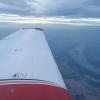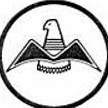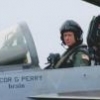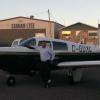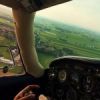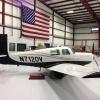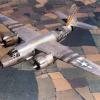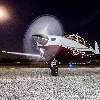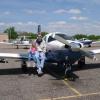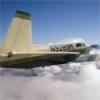Leaderboard
Popular Content
Showing content with the highest reputation on 08/26/2015 in all areas
-
Hi Bill, Just a few thoughts from a very happy Rocket owner. going over hours on the TBO doesn't concern me. Your engine won't magically disintegrate between 1600 and 2000 hours. I'd be far more concerned with going 21 years without a peek inside the case. How much do you trust every pilot / mechanic / line guy who touched the plane in the past two decades? If you are comfortable flying up high, the turbo bolted on the TSIO-520 is your best piece of deice gear. You can almost always find an ice-free altitude. I've yet to meet a Turbo Mooney owner who uses their TKS more than once or twice a year. I'm sure they are out there but I haven't met them. If you don't want to routinely fly above 10,000, the Rocket isn't the right airplane for you. She is much happier / faster above 15,000. You really can pull the power back and see 252ish numbers (speed v. fuel burn) or you can burn some dead dinosaurs and do 225 KTAS at FL210 VA to Florida is an easy trip. 1000NM is safe in zero wind or tailwind. Plane endurance > most human bladders. Getting up and over the Rockies is a non-event in this plane. The Rocket has a fully feathering prop because the engine used to live on a twin. That means you have a ridiculous 17:1 glide ratio. At FL 180, you can cross 100 miles over water and still glide to land. That makes me a lot more comfortable flying to the islands or over the mountains. I don't think the maintenance costs are much different from a 252. Might be lower because the -520 isn't working very hard in this configuration if you treat it right. But it's an airplane so it will get in your pocket. See my last post. I don't think the overhaul cost is much different. Rocket support is first class. I can't imagine flying this airplane without an instrument rating. Contrary to popular lore, it's pretty easy to slow the plane down and go downhill. You just have to plan ahead. A few minutes before you want to descend, start reducing power. I shoot for 15-20 degrees per minute cooldown rate. I can get 1,000 to 1,500 FPM downhill within a couple of minutes. During the descent I continue to reduce power (watching the cooldown rate). By the time I'm at pattern altitude, I'm below gear speed. I'm smiling if I can hit my approach speed without using speedbrakes, never exceeding 15 degrees per minute cooldown, and never increasing power after I start reducing power from my cruising altitude. Takes planning (and a little ATC help) but it usually works. That approach will hopefully let the engine live a long happy life. Be prepared to burn some gas. On short trips, you spend a large % of the time with the throttle up & full rich. That is 28GPH territory. The Rocket is a perfect fit for my mission: 1-2 people, frequent long trips where the extra 20-40 knots really adds up. That speed makes the difference between getting home and spending an extra night in a hotel. In order to get a meaningful speed increase, I'll have to buy something that burns Jet-A. The Rocket would not be a good choice for fun flying / staying current IMO. There are many cheaper options. The Rocket makes sense for someone trying to minimize travel time, not total cost of ownership. Find a good Mooney shop. Don Maxwell did my prebuy. It wasn't cheap but I knew exactly what I was getting. I like high time airplanes and don't mind damage history if the right shop did the repairs. My plane had an off-airport landing 13 years ago. So instead of a 30 year old airplane, I have some 30 year old components that were disassembled, inspected, and reassembled 13 years ago. I like that better than having an airframe that hasn't been down to its bones in 3 decades. And the price is right! High-time is relative in our airplanes. Most GA airplanes rot, not wear out. I'd rather have a plane that flew 150 hours per year over 30 years. Good luck with your search. This forum has a wealth of knowledge. Be patient and find the right bird for your mission!3 points
-
It's zinc chromate primer and it is a corrosion inhibitor. The inside wings in my 67 are not treated with zinc chromate, but the fuselage is. There is some very very light ash on the inner surface of the wings from before it was treated with corrosion X. The bare skin has a thin layer of alclad (pure aluminum) on the outer skin. https://en.m.wikipedia.org/wiki/Alclad2 points
-
I was actually toying with the idea of designing winglets and pursuing an STC. Of course, all in my spare time! LOL!!2 points
-
1 point
-
Just got my plane back from annual and I have to tip my hat to Weber Mooney Service Center in Lancaster PA. They did a phenomenal job on my plane and were able to fix the fuel selector for just a few hours of labor. They disassembled the fuel selector and found some "gunk" in the mechanism. They cleaned it up, put on some lubricant and reinstalled. Works like a champ! Smoot as butter with a nice "click" as it slips into the left and right detents. I've flown twice since getting it back 10+ Hours. knock on wood everything is working great!1 point
-
I think a perspective is in order as well. When you are buying a 50 year old airplane you can't expect it to compare to buying a new car. If you are the type of person who buys new cars and pays someone to work on them than any plane more than 10 years old is probably "trash" and you should probably either buy a new plane or reconsider ownership. If you look at weekends working in the hanger shooting bull with hanger neighbours while working on your plane as part of the experience than you'll probably have a better ownership experience. -Robert1 point
-
It's curious to see these posts repetitively come up where someone regurgitates a find and asks everyone for analysis. The ratio of "trash" to "favorable" comments is no better than 10:1. Frankly the trash talkers don't seem at all experienced (or, experienced but only in reciting mantra), have been lucky, or are hesitent to admit that they themselves didn't pick the prom queen and had to put some money into their planes (i.e. had a typical purchase experience). When buying a plane you need someone who can be trusted to tell you that the plane has good bones. I appreciate the shout-out to see if anyone knows this bird, but I wouldn't for a second discount this plane (if I were in the market) based on the input a bunch of cackling hens. (apologies to the cackling hens, but feel free to post your purchase price, equipment lists, receipts to date, and a clean bill of health from Don M or Paul L)1 point
-
Kevin, this is a very good write-up, I have to admit that at the beginnig, with my Rocket, I was either descending too late, too fast or got to my patern altitude too fast and had to use my speed brakes alot..... this amazing plane takes much more planning than less efficient ones to slow down. I'm not IFR yet, but doing it and hopefully will be within 2 or 3 months max. I now calculate my descent rate while in cruise and determine how many NM before destination I need to start my descent, then work backwords to start reducing power from the normal 31 MP that I cruise in to 25, I do that at the rate of 1 MP per 2 minutes, just to be easier on the engine for the temp changes, even though Rocket says 1 MP per minute, if you plan in advance, why not be baby the engine... It seems work well, my descent are easier now going to 25 MP over 22 RPM and my speed stays within the green arc, near yellow but still within the green... Bill, the Rocket is alot of plane, so make sure to get good transition training depending on your level of experience and as you said, MooneySpace is amazing source to seek good advice on everything...1 point
-
1 point
-
I think my '68 is the same, except the 2 spars , which have the yellow zinc chromate for their full lengths. Interesting info on Alclad.1 point
-
Excellent write up Kevin. That seems to layout the Rocket well. My mission doesn't require frequent extended legs, but frequent shorter 400nm legs with the occasional long leg. Granted, that 400nm leg would be doubled in the return flight which would be the next day or two later making it an 800nm round trip. Speed is certainly a desire, hence the reason I am on Mooney Space and not Cessna Space or some other site. (Not sure if there really is a Cessna Space, I made that up LOL). I honestly think I can afford the airplane until it comes down to maintenance other than your run of the mill stuff. I am now looking at options to increase cash flow to get the plane I want rather than settle for something else. Buying a plane sure is a process. I don't want my plane to be the one rotting on the ramp that I can't sell because I couldn't maintain it and can't afford to fly it. There is a wealth of knowledge on this site. I really appreciate everyone's point of view. It gives me what I need to make a good decision. I don't post a bunch on other people's thread, but I do read them. If I have something of value to add or a question, I will post though.1 point
-
Hijacking a thread? What did you expect? You linked to a site that's trying it's best to exploit SEO keywords for search placement while pretending to be "official" source while hiding that it's just some business trying to make a buck on people that need loans and don't know any better. They are writing loans for a higher APR than my credit card while purporting to want to "help GA". And you're talking about "purse strings have been loosened and the money is flowing" like they are doing people a favor by loaning them money at 7.5%.1 point
-
1 point
-
Mike, You can always follow the money. When it comes to finance, they aren't going to care what you are buying. They want to know that you will pay for it. The higher the interest rate, the happier they will be. Are you familiar with NexaCapital? (Do you work for them or have financial interest?) Interest rates are at an all time low and will stay low for some time. The Federal reserve is expected to start coming off the 0% overnight lending rate later this fall. The finance world thinks it will go up to 0.25 % and stay there for a bit longer. The FR is data dependent. They are keeping one eye on inflation and the other eye on unemployment. Fortunately unemployment has gone down to 6%, and has stayed there for a few months. Inflation has not arrived yet. The 7.5 % interest is pretty high. You can probably do better at a bank. Their advertisement comes across like they are offering free money. They're not. What choices do you have? If you want new electronics and have no money, see who else is going to write that loan. I am not a financial professional, but I enjoy it like watching sports... Best regards, -a-1 point
-
1 point
-
1 point
-
My '84 J is 5767Z and currently has about 5200 hours on it with an MX-20 and 430W. Never was a trainer but was the demo plane for BFG Avionics for over a decade. Similarly equipped to this one and can carry three adults with full fuel or 4 with enough fuel for a 3 hour flight with reserves. Mooniac15u is right; neither this one nor mine are eligible for the GW increase. I wouldn't so much worry about the hours if the plane has been well maintained (or repaired). I have been fortunate to find the oil analysis on mine is still available to me from the folks I use to do mine and can see as far back as 2006. It also has Maxwell, Dugosh and several other MSC annuals across its lengthy history. And as the demo plane, it had true 100 hour inspections on a regular basis. As far as the orphan avionics go, the MX-20 is no longer even repaired by Garmin, but used ones and even the newer GMX-200 are regularly on ebay if you just had to have one. the price may or may not be the perfect price, but if you want to buy and they want to sell, the only deal that can be reached is when you are both happy with the number. I say if it's the right plane for your mission, go for it! John1 point
-
1 point
-
I think it has a lot of potential if the airframe is truly NDH and corrosion free. Everything else can be fixed easily, of course. The turbo normalizer is a great feature that is not commonly found, and not really available to add today. The 201 windscreen is another very nice upgrade. The engine is an unknown and needs to be thoroughly checked if it gets valued at anything higher than a runout. It may run great for another 2000 hours, though. I'd want to go through the overhaul records and see what was done. The interior looks decent IMO and at least has tasteful colors. Paint looks OK too, certainly not bad enough to warrant a new paint job for corrosion protection. The panel is the weakest part of course. No autopilot, no modern GPS, and no engine monitor (should be required, especially with a turbo!). You can pick up a used 430W kit for ~$6500, but you'll need a new CDI as well (another $1500+). You can get a used EDM-700 system for $1200-$1500 and that would be sufficient to do the job. Autopilot...no easy way there since it doesn't look like this plane has the PC system. If you have a long term ownership horizon, then it would be a great candidate to build into what you want IMO.1 point
-
I used double sided tape to attach the antenna to the aft most plastic panel on the headliner in the center above back seat pax heads. This gives line of sight out all windows and away from other electronics. I route the wire under the headliner and the raspberry / battery sits on the hat rack. I noticed I already had metars when climbing about 1000' agl. I think it may take a while for it to download radar images though??? I wasn't up very long. I hope he adds traffic function eventually. I'm using fltplan go.1 point
-
Cruise power schedule attached. 2015-08-24 20-06-12.pdf1 point
-
I am really having to weigh my options and what I am willing to pay for a plane. I think maybe I should come down out of the clouds and look for F or J. Perhaps my dispatch rate won't be as high, but I am OK with that. I can take the airlines in the winter if I need too. Besides, the less I spend the happier momma is!1 point
-
1 point
-
Attached is the POH Supplement for my airflow systems intercooler. There is an additional cruise settings chart which is in the plane. Will upload it soon. Intercooler POH Supplement.pdf1 point
-
I purchased my Mooney with the first logbook missing covering about 6 years worth of maintenance. Short of the original paint colors being in that book, the rest of the airplanes history and more importantly it's current state of airworthiness could easily be determined. The AD's, 337's and the last 2 years of maintenance records are the important part, the rest are good bathroom reading and not referenced much anymore. I might be more concerned if this was a corporate jet, but not necessarily so for a $30k airframe. David1 point
-
Tigertrout, As pilots we should always be assessing, and seeking to minimize, risk. Using a Mooney for primary flight training is increasing your risk. How much? That depends somewhat on the individual but there is a reason that insurance quotes are high for a student pilot in a complex aircraft. Insurance companies only care about the level of risk and the statistics say that you would be at a higher risk in a Mooney than in a trainer. It is good to hear the success stories of those on Mooneyspace who transitioned with low hours. Just don't fall into the trap of confirmation bias. Don't convince yourself it will be ok just because it worked out for some others. Do your own serious risk assessment and determine if you are ready to accept the additional risk.1 point
-
Run the IO-360 at 2400rpm, 18-20" LOp and you can easily get a smooth 7gph I averaged 7-8gph during training. If you need the time, no reason to go fast. Just 120mph will do fine.1 point
-
This year at annual, I was the only plane in the LASAR hangar. Paul Lowen himself must have been bored, so he actually came out and gave my plane a throughout going over with his experienced eyes. He hasn't really done that in the past because I have had my plane there three times before and even though I had witnessed him inspecting my plane at the request of his mechanics when they wanted an opinion in the past, this time he couldn't remember ever seeing it. He discovered that whoever installed the flap gap seals didn't set it up right and my flaps were not actually hitting the stops in the full up position. So he tweaked the gap seals and got the flaps all the way up. He also checked them with the travel boards. However, when the airplane was actually flown, it was found to now bank to the left. My plane has always flown straight and level hands off. So when the ferry pilot and I flew the plane back to LASAR after picking me up (first year not doing owner assist), we both observed what looked to be a difference of 1/4 - 3/8" between the two flaps in straight and level flight. When we got to LASAR we told Paul this info and he came out with a wrench and adjusted my right flap stop about a 1/16" in his opinion. The amount was just an educated guess on his very experienced knowledge. He showed me how to adjust it (pretty self explanatory actually) and damned if it didn't fly straight and level, hands off on the way home! Paul explained that even though the flaps are interconnected with a mechanical linkage, there is enough flex in the system that you can still make quite a bit of asymmetrical adjustment. I am now hoping that with the flaps going all the way up and flying level again, she will maybe go a knot or two faster! Time will tell...1 point
-
I'm not sure why people don't just buy a Cessna 150, do their training and then resell it? The two people I know who did it this way recovered most of their cost in the year they owned them.1 point
-
I was looking through my "odds and sods" at the hangar and found that I still had a pair of the split collars I prepared for mounting a fire extinguisher on the seat adjustment bar. They are the 3/4 inch ID variety and after building them, I discovered they were the wrong size for my plane. (I later got the correct size for mine and built me another set.) Since they were furnished to me by Openskyflyer, he has first shot at them, but if he doesn't, they are available to anyone who would like to have them, for the cost of shipping.1 point


